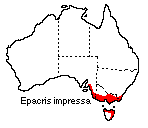 |
The generic name Epacris
is derived from the Greek 'epi', meaning 'upon', and 'akris', meaning 'a
hill', referring to the elevated habitat of some species. The specific
name impressa, Latin for 'impressed' or 'indented', refers to five
dimples on the outside of the basal part of the floral tube. Epacris
contains about forty species of evergreen shrubs which occur mainly in
temperate eastern Australia and to a minor extent in New Zealand. The family
Epacridaceae, the Australian heath family, is distributed mainly in Australia
and New Zealand. It is closely related to the Ericaceae, the much larger
heather and azalea family which has a greater occurrence in the Northern
Hemisphere.
Common Heath is a slender, upright shrub which grows to about a metre in height. The rigid, alternate leaves are stalkless and fairly narrow. They range from 4 to 16 mm in length and are sharply pointed. The tubular flowers up to 25 mm long are arranged singly in the leaf axils and are often so densely packed around the stem that the cluster of flowers assumes a cylindrical brushlike appearance. On other specimens flowers may be sparse and arranged on only one side of the stem. Flowering occurs from late autumn to late spring, reaching a peak in winter. The fruit is a capsule which splits to release minute seeds. Common Heath has many colour forms including pure white, pale pink, rose pink, crimson, scarlet and rare double flowered forms, but the pink form is the one chosen and proclaimed as Victoria's floral emblem. |
 Common
Heath occurs in coastal heathlands as well as in montane and sub-alpine
areas. It is distributed from Clyde River, New South Wales to the Mt Lofty
Ranges in South Australia. In Victoria it occurs in coastal regions and
adjoining foothills, the Grampians and the Little Desert. It is also common
in Tasmania.
Common
Heath occurs in coastal heathlands as well as in montane and sub-alpine
areas. It is distributed from Clyde River, New South Wales to the Mt Lofty
Ranges in South Australia. In Victoria it occurs in coastal regions and
adjoining foothills, the Grampians and the Little Desert. It is also common
in Tasmania.